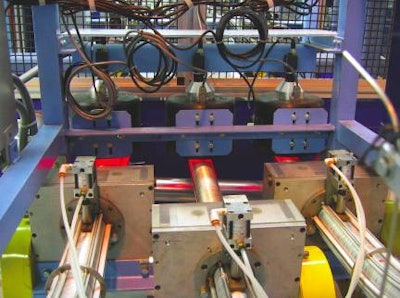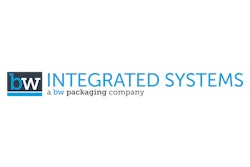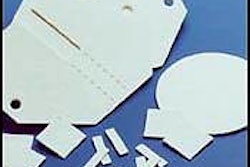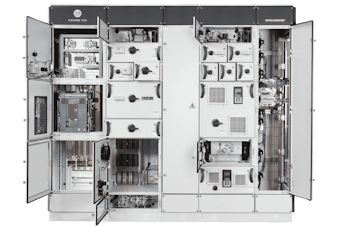
Rexam Beverage Cans Americas, the world’s largest can maker, has an eye for details. At its Valparaiso, IN, facility, aluminum can ends for two-piece beverage cans are closely examined at high speed for any defects. While the system can pinpoint defects down to the dust level, plant engineer Thomas Cortes says they are really looking for defects that require an actionable response.
In the past, the inspection had been done manually. Starting last year, inspection is now done by machine vision systems from Omron Electronics. Rexam thoroughly inspects the stay-on-tab ends before they are bagged and palletized for delivery to customers.
Before, Rexam had bagged the finished ends by hand when the ends were also visually inspected for defects and contamination. But the ability of the human eye to judge small defects continuously, and especially at high speeds, is not always reliable.
Starting in mid-2004, Rexam installed 12 new Fleetwood automatic counter baggers/bag palletizers to replace manual final packaging. At a rate of hundreds of ends/min, the units place rows of back-to-back ends into premade paper bags that are later shipped to Rexam’s customers. Coinciding with the automation upgrade, human inspectors were replaced with the electronic vision sensors that are better able to identify defects in a high-speed, 24/7 environment, according to Rexam.
Every automatic bagger/palletizer has multiple infeed lanes, each of which is equipped with its own Omron Electronics F150-3 machine vision controller, an F150KP keypad programmer, and an F150-S1A C camera with 659 x 494 pixel resolution. The unit stores up to 23 images, enabling it to inspect a variety of different product configurations. Each camera is mounted over a can end infeed lane with an RVSI/NER Nerlite® Continuously Diffuse Illuminator also known as a Cloudy Day Illuminator (CDI). The system inspects the edge of the ends as they pass by back-to-back below.
Omron distributor Kiser Controls, whose Controls Division specializes in vision sensor systems installation, began working with Rexam in the fall of 2003, doing initial testing in order to understand the challenges presented by the can end line. In December 2003, Kiser presented a proof of concept to Rexam, and shortly after began operational testing at its own facility. With the concept finalized, Kiser demonstrated the vision system on an existing line at Rexam’s Valparaiso plant, and installed it for a full-scale test in early summer 2004. The system became fully operational in September 2004.
How the system works
Shiny aluminum can ends are extremely reflective and can effectively “blind” most cameras and sensors. The CDI illuminator light is designed for such critical applications where any surface reflections can cause a vision system to see defects where none exist. The CDI provides diffuse lighting that reduces reflection and reveals the dark spots that indicate the presence of contaminants.
The F150-S1A C camera and CDI light is mounted about a foot above the infeed lane where the back-to-back can ends enter the bagging area. The system inspects for dark areas on the edges of the ends that indicate the presence of contaminants. If a spot is detected, the entire batch of ends is identified and segregated for later manual inspection during bagging.
Rexam has learned that debris most often occurs when metal coils are changed, or during product changeovers. At those times, a black-colored marker batch of ends is inserted into the production line. When the inspection system detects the marker, it rejects a preset number of ends following the change, to clear the line.
The markers also alert the system that a new product is to be inspected, and the system automatically switches to the appropriate stored image. Cortes says that no manual adjustment to the vision system is needed when changing, for example, from aluminum to gold-tinted ends.
Although it is not intended to do so, the Omron vision system can also detect deformed ends, which occasionally occur, usually due to variations in metal quality. Because the deformed end will not nest closely with other ends, it creates a gap that triggers the system just as the dark color produced by debris does.
The new system has eliminated contaminated product reaching customers, according to Rexam. “We have been catching defective ends with the system,” affirms Cortes. Rexam has automated product changeovers as well, increasing productivity, and product quality, thus reducing the number of product returns. That’s a good return on investment that’s easy to see.


























